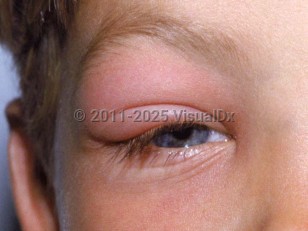Honeybee sting in Child
Alerts and Notices
Important News & Links
Synopsis

There are 7 species of honeybees. They are native to Europe, Asia, and Africa but have been imported and domesticated in other countries. When domesticated, they live in man-made hives in large colonies where they are used to produce honey and pollinate fruits, vegetables, and seed crops. Honeybees are not aggressive but will sting to defend their nests if disturbed. Africanized honeybees, unlike most honeybees, are very aggressive and will swarm and sting with the slightest disturbance (see Africanized bee sting).
Honeybees sting defensively. The barbed stinger separates from the abdomen allowing the venom to continue to pump into the wound while alarm pheromones are released to attract other bees. The principal components of honeybee venom include the peptides melitin, mast cell degranulating peptide, apamin, and adolapin. Melitin, a strongly basic peptide, damages cell membranes and is responsible for the pain associated with the sting. Mast cell degranulating peptide causes histamine release and an inflammatory reaction. Apamin is a neurotoxin that acts principally on the spinal cord, and adolapin has anti-inflammatory activity. The two main enzymes are phospholipase A and hyaluronidase. Phospholipase A and melitin are thought to be the major venom allergens and account for much of the acute lethality.
The lethal dose of honeybee venom is approximately 15 stings/kg. However, one sting in a sensitized person can be fatal due to anaphylaxis. Most deaths related to honeybee stings (with the exception of Africanized honeybees) are due to anaphylaxis.
Four possible reactions are seen after a honeybee sting: local reactions, regional reactions, anaphylaxis and, rarely, delayed-type hypersensitivity. In addition, multiple stings can cause systemic envenomation and death from direct venom toxicity.
Local sting reactions include immediate pain, swelling, and redness at the sting site that often subsides within a few hours.
Regional reactions (exaggerated local reactions) occur in some individuals with extended swelling that can last 2-7 days. These reactions are not allergic in origin.
Anaphylactic reactions cause diffuse urticaria, pruritus, angioedema, bronchoconstriction, respiratory distress, hypotension, loss of consciousness, and cardiac arrhythmias. Onset of life-threatening, anaphylactic signs typically occur within 10 minutes of the sting but can be delayed in onset for hours.
Delayed-type hypersensitivity can manifest as serum sickness, vasculitis, neuritis, encephalitis, nephritis, and coagulation defects.
Systemic envenomation from multiple stings may cause vomiting, diarrhea, generalized edema, dyspnea, hypotension, tachycardia, acute myocardial infarction, atrial fibrillation, cardiovascular collapse, and cerebral infarction. Widespread necrosis of skeletal muscle with hyperkalemia, acute tubular necrosis with renal failure, hepatorenal syndrome with hemolysis, acute pancreatitis, and disseminated intravascular coagulation have been reported.
Honeybees sting defensively. The barbed stinger separates from the abdomen allowing the venom to continue to pump into the wound while alarm pheromones are released to attract other bees. The principal components of honeybee venom include the peptides melitin, mast cell degranulating peptide, apamin, and adolapin. Melitin, a strongly basic peptide, damages cell membranes and is responsible for the pain associated with the sting. Mast cell degranulating peptide causes histamine release and an inflammatory reaction. Apamin is a neurotoxin that acts principally on the spinal cord, and adolapin has anti-inflammatory activity. The two main enzymes are phospholipase A and hyaluronidase. Phospholipase A and melitin are thought to be the major venom allergens and account for much of the acute lethality.
The lethal dose of honeybee venom is approximately 15 stings/kg. However, one sting in a sensitized person can be fatal due to anaphylaxis. Most deaths related to honeybee stings (with the exception of Africanized honeybees) are due to anaphylaxis.
Four possible reactions are seen after a honeybee sting: local reactions, regional reactions, anaphylaxis and, rarely, delayed-type hypersensitivity. In addition, multiple stings can cause systemic envenomation and death from direct venom toxicity.
Local sting reactions include immediate pain, swelling, and redness at the sting site that often subsides within a few hours.
Regional reactions (exaggerated local reactions) occur in some individuals with extended swelling that can last 2-7 days. These reactions are not allergic in origin.
Anaphylactic reactions cause diffuse urticaria, pruritus, angioedema, bronchoconstriction, respiratory distress, hypotension, loss of consciousness, and cardiac arrhythmias. Onset of life-threatening, anaphylactic signs typically occur within 10 minutes of the sting but can be delayed in onset for hours.
Delayed-type hypersensitivity can manifest as serum sickness, vasculitis, neuritis, encephalitis, nephritis, and coagulation defects.
Systemic envenomation from multiple stings may cause vomiting, diarrhea, generalized edema, dyspnea, hypotension, tachycardia, acute myocardial infarction, atrial fibrillation, cardiovascular collapse, and cerebral infarction. Widespread necrosis of skeletal muscle with hyperkalemia, acute tubular necrosis with renal failure, hepatorenal syndrome with hemolysis, acute pancreatitis, and disseminated intravascular coagulation have been reported.
Codes
ICD10CM:
T63.441A – Toxic effect of venom of bees, accidental, initial encounter
SNOMEDCT:
89910002 – Poisoning by honey bee sting
T63.441A – Toxic effect of venom of bees, accidental, initial encounter
SNOMEDCT:
89910002 – Poisoning by honey bee sting
Look For
Subscription Required
Diagnostic Pearls
Subscription Required
Differential Diagnosis & Pitfalls

To perform a comparison, select diagnoses from the classic differential
Subscription Required
Best Tests
Subscription Required
Management Pearls
Subscription Required
Therapy
Subscription Required
References
Subscription Required
Last Updated:02/21/2018
 Patient Information for Honeybee sting in Child
Patient Information for Honeybee sting in Child
Premium Feature
VisualDx Patient Handouts
Available in the Elite package
- Improve treatment compliance
- Reduce after-hours questions
- Increase patient engagement and satisfaction
- Written in clear, easy-to-understand language. No confusing jargon.
- Available in English and Spanish
- Print out or email directly to your patient
Upgrade Today

Honeybee sting in Child

